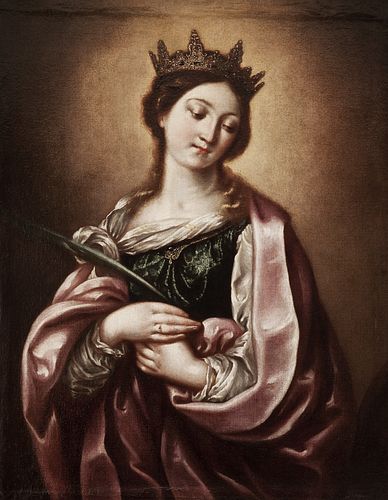Spanish school of the seventeenth century. Circle of ALONSO CANO (Granada, 1601 - 1667), based on a model by RENI, Guido (Calvenzano di Vergato, Bolog
Lot 95
About Seller
Setdart Auction House
Carrer Aragó 346
Barcelona
Spain
Setdart Subastas was born in 2004 and is currently the first online art auction in Spain with solidity, prestige and reliability guaranteed by our more than 60,000 users. Setdart has a young, dynamic and enterprising team ready to successfully manage the purchase and sale of art works through custom...Read more
Estimate:
EUR€8,000 - EUR€10,000
$8,602.15 - $10,752.69
Absentee vs Live bid
Two ways to bid:
- Leave a max absentee bid and the platform will bid on your behalf up to your maximum bid during the live auction.
- Bid live during the auction and your bids will be submitted real-time to the auctioneer.
Bid Increments
| Price | Bid Increment |
|---|---|
| EUR€0 | EUR€10 |
| EUR€200 | EUR€25 |
| EUR€500 | EUR€50 |
| EUR€1,000 | EUR€100 |
| EUR€3,000 | EUR€200 |
| EUR€5,000 | EUR€500 |
| EUR€10,000 | EUR€1,000 |
| EUR€20,000 | EUR€2,000 |
| EUR€50,000 | EUR€5,000 |
About Auction
By Setdart Auction House
Oct 20, 2021
Set Reminder
2021-10-20 07:30:00
2021-10-20 07:30:00
America/New_York
Bidsquare
Bidsquare : OLD MASTERS
https://www.bidsquare.com/auctions/setdart-auction-house/old-masters-7700
Setdart Auction House sofia@setdart.com
Setdart Auction House sofia@setdart.com
- Lot Description
Spanish school of the seventeenth century. Circle of ALONSO CANO (Granada, 1601 - 1667), based on a model by RENI, Guido (Calvenzano di Vergato, Bologna, 1575 - Bologna, 1642). "Saint Catherine." Oil on canvas. Size: 100 x 80 cm; 128 x 106 cm (frame). The work presents a background of focally illuminated, on which stands out the figure of the portrayed, St. Catherine of Alexandria, a lady of rich clothes and fine features that diverts his gaze to the ground. Her fine gestures attract attention, and she manages to highlight her distinctive attributes, such as the palm of martyrdom or the queen's crown. The saint's clothing, the whitish complexion, the magnificent and detailed drawing of the work, the chosen coloring, the shapes of the woman's face and neck, the lack of accessories that distract the viewer's attention, the size of the figure and the objects, etc. are all reminiscent of works by Guido Reni, such as his "Saint Catherine", painted around 1606 and now in the Prado Museum, which Cano's circle was able to see through engravings. Because of its formal characteristics we can place this work in the circle of followers of Alonso Cano, painter, sculptor and architect key to the Spanish Baroque. Cano was also the initiator of the Granada school of painting and sculpture, and his disciples included Juan de Sevilla, Pedro Atanasio Bocanegra, José Risueño, Pedro de Mena and José de Mora. Son of an important assembler of altarpieces and possibly also a draftsman, Alonso Cano was initiated in architectural drawing and imagery by his father, with whom he collaborated from a very young age. In 1614 or 1615 he moved with his family to Seville, where he soon joined the painting workshop of Francisco Pacheco, by then the most prestigious master of the city, in fact Velázquez's master, with whom Cano became a close friend. As a sculptor, it is traditionally considered that he must have trained with Juan Martínez Montañés, although there is no documentary evidence of this. In 1624 he signed his first known painting, and two years later he obtained the title of master painter. In 1638 he moved to Madrid, and was soon appointed chamber painter and drawing teacher of Prince Baltasar Carlos. There he became acquainted with the royal collections, which will lead his language to evolve from its early Caravaggism to a more colorful and elegant language, sometimes related to Van Dyck. However, in 1644 he was accused of murdering his wife, which led him to take refuge in Valencia. A year later he returned to Madrid, and in 1652 he returned definitively to Granada, where he obtained a position in the cathedral thanks to the influence of Philip IV. There he completed the decoration of the main chapel and became the main master of the cathedral. Works by Alonso Cano are currently kept in the Prado Museum, the Museum of Fine Arts in Seville, the Hermitage in St. Petersburg, the Louvre in Paris, the Metropolitan in New York, the J. Paul Getty in Los Angeles and the Art Institute of Chicago, among other important collections in Spain and abroad. Iconographically, the work represents Saint Catherine of Alexandria, a Christian martyr of the 4th century. Endowed with a great intelligence, she soon stood out for her extensive studies that placed her on the same level as the greatest poets and philosophers of the time. One night Christ appeared to her and she decided, at that moment, to consecrate her life to him, considering herself, since then, his fiancée. She refused to marry the emperor Maximian, and victoriously held a dispute with fifty philosophers sent by him to demonstrate the inanity of the Christian faith. Furious, Maximian condemned her to be torn by a wheel with spikes. The wheel miraculously breaks, and Catherine is finally beheaded.
- Shipping Info
-
In-house shipping available. Please inquire at admin@setdart.com.
-
- Buyer's Premium



 EUR
EUR CAD
CAD AUD
AUD GBP
GBP MXN
MXN HKD
HKD CNY
CNY MYR
MYR SEK
SEK SGD
SGD CHF
CHF THB
THB








